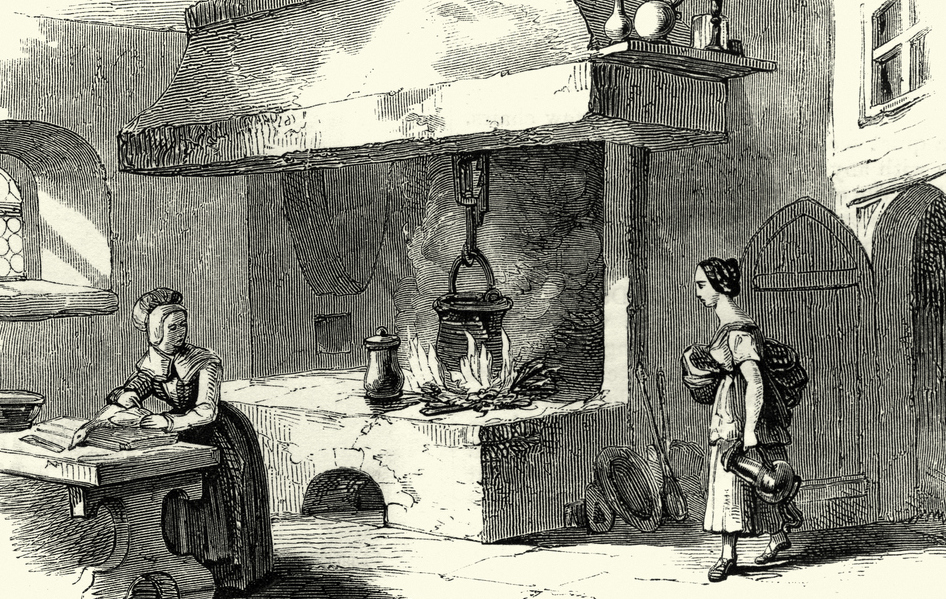What’s the one thing that is needed to cook food? Heat. In 2014, archeologists found evidence of the very first hearth, according to National Geographic. Located in a cave in Tel Aviv, this hearth is said to be 300,000 years old, and contained ash and bits of bone. Since scientists were able to use infrared spectroscopy on the remnants found in this cave, they were able to observe layers of ash. This indicated that the hearth wasn’t the location of a single meal — it was a place where families returned time and time again to prepare meals. It is thought that the earliest form of cooking took place around the warmth of the fire there.
Cooking has obviously changed drastically since then. While the human race once depended on the spoils of hunting and gathering, today we hop in our cars or ride a bus to meander through the aisles of a grocery store. Then, those foods are heated in a microwave or cooked in an oven. For most living in developed countries, preparing food to eat has never been so convenient.
Even in the last 500 years, amazing advances have been made that have completely transformed the way we prepare the food we eat. Here are some of the most interesting things about the more recent evolution of cooking.
The 300-Year-Old Cookbook

Westminster City Archives/https://lostcookbook.wordpress.com
Thanks to food historians like Annie Gray, and preserved cookbooks from long ago, we know a whole lot about what cooking was like 300 years ago.
The cool thing about this 300-year-old artifact, The Unknown Ladies Cookbook, is that it isn’t simply filled with the recipes from one chef. Instead, it is full of handwritten recipes by several different women, believed to belong to the same family, between the years of 1690 and 1830. Gray has been cooking up these recipes from Great Britain and has written all about it on her blog, giving us a great point of reference as we look back on the history of cooking.
Carrots Stole The Show
According to the pages of The Unknown Ladies Cookbook, Brits cooking 300 years ago relied heavily on their vegetable gardens to fill plates.
Specifically, carrots stole the show. For NPR, Gray describes a sweet dish, served as a second course, which involved filling a boiled carrot with sugar and fruits. Plus, this isn’t the only time in history when carrots had their moment. In the 1700s, carrots were mixed with eggs, crumbs, and cream, and deep fried into a puff. They were also used heavily in carrot puddings, which could be savory or sweet depending on the meal they were meant to be eaten during.
Waste Not, Want Not
Cooking meat in Britain 300 years ago typically meant using every last bit of the animal.
For example, the cookbook Gray has been using includes recipe likes cow’s tongue mincemeat pie. According to NPR, this practice changed over time for two reasons, Firstly, the World Wars resulted in the loss of hired help, which meant more labor intensive, skilled cooking practices were abandoned. And secondly, Britain became more urban and this changed the general appetite for these inventive meals.
Family Meals Ruled The Home
And no, there weren’t any phones allowed at the dinner table… because there weren’t any phones.
In today’s world, we’ve grown accustomed to eating on the go, skipping meals, or reheating leftovers in the microwave to stay on top of busy work or school schedules. Boy, is that different from cooking in the 1800s! It used to be that the day was scheduled around family meals during which people actually talked about their day.
Women’s Work
As a housewife, women were expected to spend a lot of their day preparing food.
This began with preparing an early morning fire, according to NCpedia, that was kept going all day to cook meals. Family members didn’t have the option not to help out, either, since food preparation was such a time-consuming undertaking that had to be repeated day after day. Though women were often confined to the kitchen, they still required help when it came to preparing several meals a day for their family.
Men’s Work
Yes, men also had to contribute in some way.
A trip to the grocery store may be an occurrence that happens several times a week in the modern world, but in the 1800s, that wasn’t the case. Just like the wives were spending much of their time preparing food, most men and boys expected to spend a lot of time farming food to eat. It was truly a group effort when it came to making sure everyone had enough to eat.
Farm Fresh Wasn’t A Novelty
Having a garden and livestock was more of the norm.
In addition to growing fruits and vegetables in a garden, farmers had livestock for the purpose of meat, milk, and eggs. Horses were also raised to help power important tasks like plowing, since doing it all by hand would require much more time and energy. It is easy to imagine how this kind of undertaking could take up most of the daylight hours!
Butchering Was A Family Affair
People weren’t as removed from food preparation as they are today.
Unless you live on a farm that produces meat, you’re probably removed from the act of butchering an animal for meat. This hasn’t always been the case. At one time, butchering a pig was a family affair that began in the early morning hours at the beginning of winter, according to Berks-Mont News.
Preservation Was An Art Form
Who needs fridges and freezers?
Depending on the seasons to guide what was eaten, many farmers and their families learned creative ways to preserve food. This included smoking, salting, and drying meats. Many fruits and vegetables were also eaten while still in season, but root vegetables were carefully stored underground. Some fruits and vegetables were preserved in salt or brine as well.
Napoleon Funded The Invention of Canning
Feeding the troops wasn’t easy.
To solve this problem, in the 1700s, Napoleon offered a reward of 12,000 francs to the inventive person who could come up with an effective way to solve that challenge. After years of experimentation, a man named Nicolas Appert won the prize. His method involved putting food in glass jars sealed with wax and boiled in hot water. His invention would change food preservation and cooking forever.
Unbreakable Tin And Canned Food
Because glass jars aren’t exactly ideal.
Bryan Donkin built the first canning factory in 1812, but tin cans wouldn’t become widely used until the can-opener became a common household product in the 1850s. In addition to changing the way foods were eaten and stored, this was the birth of the tin can industry. He is also credited as the inventor of the first papermaking machine.
The Ice Box
Finally, a more modern method of preservation!
Speaking of preservation, in the 19th and 20th centuries, foods were kept cool in an ice box filled with ice delivered to homes. Even though 1748 is the official date of the first artificial refrigerator, it took some refining before it was ready to be used in the home. It wasn’t widely used until General Electric released their first machine in 1927.
The World’s First Stove
Ice boxes were just the beginning.
Even though food has been cooked over a fire for as long as 300,000 years, the stove is a fairly modern invention. According to Encyclopedia Britannica, the first stove we have in the history books was invented in 1490. It was made of brick and tile, and would become the first of many iterations of the modern stove.
Another Franklin Original
Benjamin Franklin played a role in the refining the stove.
In 1740, he invented a small, free-standing fireplace with doors that would become the design inspiration for the pot belly stove. At that time, the stove was filled with wood, but eventually, stoves would use coal followed by natural gas and electricity for heat. Really, if you look at the history of the stove, it’s a pretty good indication of how cooking preparation has changed over time.
The Microwave Oven is Introduced…
The first microwave oven was tested out in 1954, and cost between $2,000 and $3,000.
By 1955, a domestic model was introduced at a lower price point. (Well, kind of. It sold for $1,295!) It then became a popular household purchase. Thanks to gradual price drops, this speedy alternative to stove top cooking became widely popular, and by 1975, a million models had been sold in the United States. Fun fact: Frozen dinners reheated in the oven were already a big deal at that point, sold originally to bars in the 1940s.
Some Foods Are Here to Stay
There are those staples we will always love to eat.
Although what we eat has changed drastically over time, there are some foods that have become ingrained into certain cultures. With at least a hundred years of history under the belt, it is probably fair to say there are certain foods, like bread, meats, and dairy products that are here to stay.
An American Classic
Historians say the earliest written recipe we have for meatloaf is from the 1870s.
The recipe begins with chopping up any meat that is already on hand. From there, the recipe is almost identical to classic meatloaf today. Milk, bread, salt, pepper, and onions are all added to the meat before it’s baked in a hand-shaped mound. It says a lot that even though meatloaf was enjoyed long ago, it’s still a popular favorite today.
In Mexico, French Cooking Left A Mark
Celebrating Cinco da Mayo commemorates the day in 1862 when the Mexican army won an important battle against the French, who had occupied their home.
For the next five years, the unwelcome French would keep living in Mexico. While they were there, they influenced Mexican cooking and evidence of the French occupation can still be found in Mexican foods today, according to NPR. This goes to show that how countries interact with one another can have a significant impact on the foods one eats.
Crepes Join Up With Mexican Cuisine
Today, evidence of the French occupation of Mexico can still be seen in Mexican cooking.
Specifically, the crepe is popular as both a savory dish and an after-dinner dessert. Fill them with cheese and meat, or cover them in syrup and nuts. Crepes Cajeta is a delicious, traditional Mexican treat filled with homemade caramel sauce and topped with chopped pecans. “In Mexico, one of the most traditional desserts is crepas con cajeta,” Mexican chef Pati Jinich told NPR. “That’s what I used to have for every birthday in Mexican restaurants. And crepes are like a thousand times French.”
The World’s Oldest Bread
What’s 150 years of history when you’re competing with bread?
In 2018, archeologists found crumbs from what might be the oldest bread on earth. They believe these crust crumbles are 14,000 years old, which means the bread was baked before farming was a common practice. It’s crazy how something as simple as ancient breadcrumbs can tell you a lot about the people who ate the bread in the first place.
The human experience of cooking is a long and varied history, with many gaps in information we may never discover. We each have our own food histories, too, and we’d love to hear a little about yours.

